
Publisher:
Bonnie King
CONTACT:
Newsroom@Salem-news.com
Advertising:
Adsales@Salem-news.com

~Truth~
~Justice~
~Peace~
TJP
Feb-24-2011 14:41

 TweetFollow @OregonNews
TweetFollow @OregonNews
Military Ethics: 'Do the Right Thing'
Robert O'Dowd Salem-News.comThe veteran who seeks medical care and disability compensation when there’s a delay in the onset of injuries is often met with open hostility by the DOD, the VA, and his own medical care providers.
 Special thanks to Veterans Today |
(CAMP LEJEUNE, N.C.) - The Navy and Marine Corps are faced with the choice of ‘doing the right thing’ by supporting legislation to provide medical care and compensation to those injured from exposure to environmental hazards while on active duty or facing the backlash of a public outcry for not doing so, including lawsuits from dependents and civilian workers that could run into the billions of dollars.
Based on our investigation of three military installations, the actions taken to date by the Navy and Marine Corps are not supportive of veterans and others with injuries linked by medical care providers to exposure to toxic chemicals and radiation. The military continues to deny any responsibility for deaths and serious medical conditions, despite a number of Congressional hearings and mounting evidence of causality.
By law, veterans cannot file tort suits for injuries on active duty, even when the injuries are caused by government negligence. Their only recourse is to file a VA Compensation and Disability Claim. The Defense Department can be supportive in these claims by volunteering information relating to their exposures or not. Based on information from veterans, the information needed by veterans has to be obtained the hard way by filing time consuming Freedom of Information (FOIA) requests, often with the intercession of their Congressional representatives.
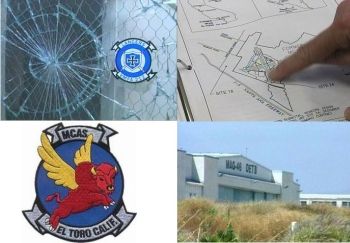 Images of the contaminated MCAS El Toro |
Military service is not a hazard-free occupation. Those serving in bases outside of combat zones can be subject to exposures to environmental hazards that can be as deadly as driving over IEDs or begin hit by an RPG.
The differences are that unlike a veteran wounded in combat who is treated very often within minutes with first class medical care and monitored to ensure full recovery, the veteran exposed to dioxin, carcinogens like trichloroethylene (TCE), perchloroethylene (PCE), vinyl chloride, benzene, fuels, and radiation often has no idea of the exposure until years after separation from military service when cancer has attacked his body and there’s no way to ‘connect the dots’ to the military.
These environmental hazards at three military bases, two in the U.S. and the other in Japan are the subject of a manuscript expected to be released for publicaton later this year. The tentative title is “A Few Good Men, Too Many Chemicals.”
MCAS El Toro (closed in July 1999) and Camp Lejeune are the two U.S. bases on the National Priorities List, a list of the most environmentally hazardous sites with known or threatened releases of hazardous substances in the United States and its territories. Naval Air Facility Atsugi may have made this list, but only military installations in the U.S. and its territories are eligible.
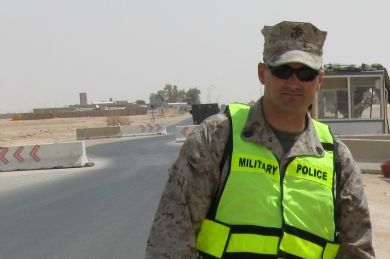 Marine MP at Iraq's al Asad air base. Photo by Tim King |
Like those injured from trauma-related services in Afghanistan and Iraq, veterans, their dependents and civilian employees of Marine Corps Base Camp Lejeune, former Marine Corps Air Station, El Toro, and Naval Air Facility Atsugi, injured by environmental hazards need medical care, but unlike those in active military service, the care is not forthcoming from the either the Department of Defense or the Department of Veterans Affairs.
Congressional hearings have been held on Lejeune and Atsugi,the two active military bases. For Lejeune and Atsugi, bills were introduced into 111th Congress but no legislation passed. El Toro is not on anyone’s radar; the base was sold to a real estate joint venture in 2005 and the former veterans sickened by the multiple contaminants left to their own resources.
These three military installations are by no means unique but are representative of the environmental hazards faced by veterans of the 130 military bases on the National Priority List, commonly referred to as the EPA Superfund sites
When exposures to chemical, radiological or other agents cause immediate harm while on active duty, medical care is provided by the military, the condition is documented in the medical service record and upon discharge, the veteran, if the medical condition is chronic, is eligible for VA medical care and compensation benefits.
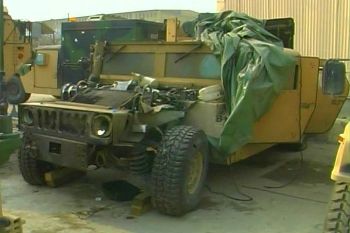 Blown up HUMVEE in Afghanistan. Photo: Tim King |
However, when the onset of a medical condition from exposure to environmental hazards is delayed, not exhibited sometimes for decades after separation from the military, then the burden of proof of service connection falls on the veteran. To make this connection, the veteran needs the cooperation of the Defense Department to provide evidence of exposure at a particular military installation and a nexus opinion from a medical care provider linking his current disability to military service.
The veteran who seeks medical care and disability compensation when there’s a delay in the onset of injuries is often met with open hostility by the DOD, the VA, and his own medical care providers.
For military installations listed on the NPL, the EPA Superfund data base lists the Contaminants of Concern found in the environment and the health effects from exposure to particular COCs. Too often this is the only government source of information available. Some data can be obtained from the military service via the Freedom of Information Act (FOIA), if the records exist and can be identified in the request. For installations not on the NPL, the only source of information is the military service who typically maintains a hostile attitude to helping veterans document their possible exposure to environmental hazards.
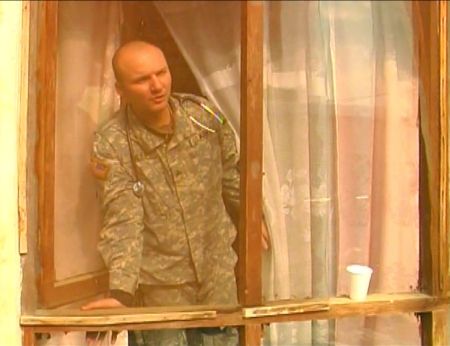 Medic in the window of Afghan home takes a quick pause during a busy |
More often than not, doctors are hesitant to become involved with the government on a VA disability claim. In this situation, the only alternative is for the veteran is to pay for the non-reimbursable costs of an independent medical nexus opinion, running into several thousand dollars. In fact, exposure to environmental hazards can impose far greater health risks in the near or distant future, including neurological damage, infertility, cancer, heart disease, and other conditions that require substantial medical care, cause disability, and in some cases cause premature death.
The current wars in Afghanistan and Iraq have focused on the need for substantially improved trauma-related services. This is a critically important issue that has been addressed in the national media, numerous reports, the subject of intense scrutiny and ongoing effort. From all reports the DOD and VA recognize the necessity of providing medical health care and compensation to those injured. For those who served honorably and were injured in these war zones, they deserve no less.
For Vietnam veterans, the fight to win presumptive disability for exposure to Agent Orange took decades to bring about. Their story is well known. Other hazardous agents, many now highly controlled or banned, have been and continue to be used at military bases and in military actions. These have caused serious illnesses in veterans and active duty personnel. The service men and women suffering from hazard-related diseases and disabilities require rapid response from the federal government, rather than the delayed actions experienced by too many veterans in the past.
 MCAS El Toro: view from a toxic hangar. Photo by Tim King |
The story of El Toro includes the murder of senior Marine Corps officer. Just prior to his death, the official MWR (Morale, Recreation, and Welfare) file at El Toro was purged to prevent the Marine Corps Inspector General from learning the details of the maintenance support provided by base personnel for unmarked civilian aircraft. The motive for his murder was to prevent him from talking about the use of unmarked civilian aircraft to fly guns to Central and South America and drugs into the U.S. to support the Nicaraguan Contra War. Forensic experts outside of the government say he was murdered. Like the base wells now sealed in concrete, dead men don’t talk.
The very first stop for a surprise visit by the Marine Corps Inspector General to El Toro in January 1991 was the facility that housed the MWR file. The non-commissioned officer (NCO) who reported the MWR file purged to the IG was later murdered in Florida, his civilian apartment cordoned off by military police that cited national security interests as their reason for this highly unusual action. His murder remains unsolved today.
Like the purged government MWR file, TCE drums were buried on El Toro to prevent their discovery by the Marine Corps Inspector General after their use was no longer authorized.
Missing government Superfund records at El Toro include 30 years of engineering drawings for the base’s water distribution system (1955-1985), all of the original well construction drawings, the dates the base wells were abandoned, the government contract file for municipal water services with Irvine Ranch Water District.[i]
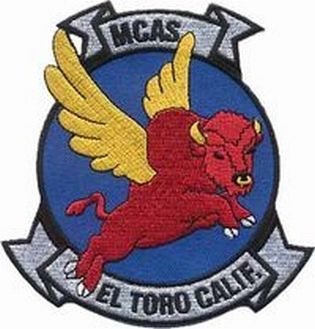 El Toro's logo was created by Disney Studios. |
The official government contract file would include the justification for the award of the negotiated municipal water services contract, including the technical justification for the municipal water services when there was no known shortage of water in the aquifer at El Toro.[ii] The Navy cites lack of well pumping records after December 1950. Our review showed that the pumping records were at best inaccurate.
At El Toro, the Navy was responsible for remediation and instructed its consulting engineer to inspect the first well scheduled for destruction in March 1998. The consultant reported the well screen interval in the contaminated aquifer. A water sample found TCEs in the well above the Maximum Contaminant Level (MCL). In another well sealed in 2007, the Navy’s consulting engineer reported petroleum hydrocarbons (primarily motor oil) at a concentration of 1,600,000 milligram per kilogram (mg/kg), 170,000 mg/kg of diesel and gasoline, and methylene chloride, naphthalene, and 1,2,4-trimethylbenzene positively identified with the result less than “the Reporting Limit and greater than the Method Detection Limit.” Another agricultural well on base was found contaminated with low levels of TCE in 1985 by the Orange County Water District. After the well screen interval was found in the contaminated aquifer, the Navy sealed all remaining wells in concrete without looking for well screen intervals, the first point that water and contaminants enter a well. No physical inspection is possible now. All the wells are wearing concrete shoes.
No Marine veteran of MCAS El Toro was notified of their possible exposure to chemical toxins and their health effects. Like other veterans of the 130 military bases that are on the National Priorities List (EPA Superfund sites), Marine veterans of this base in Southern California who may be seriously ill from exposure to toxic chemicals have not connected the dots to military service.

On the East Coast, Camp Lejeune’s contaminated water wells have been the focus of national media attention for several years. Several Congressional bills have been introduced but, no legislation passed to provide health care to the injured veterans and their dependents.
The Marine Corps has notified some Lejeune veterans, but only after legislation was passed requiring them to do so.
Veterans and dependents who were stationed at National Air Facility, Atsugi, Japan, while a Japanese incinerator spewed forth deadly dioxin only several feet above ground level, still await government health care.
The U.S. Justice Department sued the owner of the incinerator in a Japanese court. Before the case could be heard, the Japanese government purchased the private incinerator for $40 million and then quickly dismantled it. A Senate bill to provide health care for both Atsugi and Lejeune veterans and establish a scientific Advisory Board to evaluate environmental hazards at military installations failed to reach the floor for a vote and died with the end of the 111th Congress.
Faced with a public health problem at Lejeune, the Marine Corps chose to wage a public relations campaign, denying responsibility for injuries and deaths caused by the contaminated well water (1957-1987). The outcome may be settled by five lawsuits in Federal court, filed on behalf of former Lejeune dependents.
The documentation on Lejeune’s wells includes exposure to benzene, a known human carcinogen. There’s no need to delay health care and reasonable compensation at Lejeune. In the end, the Federal court may force a settlement, leaving senior Marine Corps leadership in the position of apologizing for throwing Marine veterans and their dependents ‘under the bus’ and doing irreversible damage to their motto, ‘Semper Fidelis.’
 Bob O’Dowd is a former U.S. Marine with thirty years of experience on the east coast as an auditor, accountant, and financial manager with the Federal government. Half of that time was spent with the Defense Logistics Agency in Philadelphia. Originally from Pennsylvania, he enlisted in the Marine Corps at age 19, served in the 1st, 3rd, and 4th Marine Aircraft Wings in 52 months of active duty in the 1960s. A graduate of Temple University, Bob has been married to Grace for 31 years. He is the father of two adult children and the grandfather of two boys. Bob has a blog site on former MCAS El Toro at mwsg37.com. This subject is where Bob intersected with Salem-News.com. Bob served in the exact same Marine Aviation Squadron that Salem-News founder Tim King served in, twenty years earlier. With their combined on-site knowledge and research ability, Bob and Tim and a handful of other ex-Marines, have put the contamination of MCAS El Toro on the map. The base is highly contaminated with TCE, trichloroethelyne
Bob O’Dowd is a former U.S. Marine with thirty years of experience on the east coast as an auditor, accountant, and financial manager with the Federal government. Half of that time was spent with the Defense Logistics Agency in Philadelphia. Originally from Pennsylvania, he enlisted in the Marine Corps at age 19, served in the 1st, 3rd, and 4th Marine Aircraft Wings in 52 months of active duty in the 1960s. A graduate of Temple University, Bob has been married to Grace for 31 years. He is the father of two adult children and the grandfather of two boys. Bob has a blog site on former MCAS El Toro at mwsg37.com. This subject is where Bob intersected with Salem-News.com. Bob served in the exact same Marine Aviation Squadron that Salem-News founder Tim King served in, twenty years earlier. With their combined on-site knowledge and research ability, Bob and Tim and a handful of other ex-Marines, have put the contamination of MCAS El Toro on the map. The base is highly contaminated with TCE, trichloroethelyne
You can email Bob O’Dowd, Salem-News.com Environmental and Military Reporter, at this address: consults03@comcast.net
Articles for February 23, 2011 | Articles for February 24, 2011 | Articles for February 25, 2011

Quick Links
DINING
Willamette UniversityGoudy Commons Cafe
Dine on the Queen
Willamette Queen Sternwheeler
MUST SEE SALEM
Oregon Capitol ToursCapitol History Gateway
Willamette River Ride
Willamette Queen Sternwheeler
Historic Home Tours:
Deepwood Museum
The Bush House
Gaiety Hollow Garden
AUCTIONS - APPRAISALS
Auction Masters & AppraisalsCONSTRUCTION SERVICES
Roofing and ContractingSheridan, Ore.
ONLINE SHOPPING
Special Occasion DressesAdvertise with Salem-News
Contact:AdSales@Salem-News.com

Salem-News.com:
googlec507860f6901db00.html

Terms of Service | Privacy Policy

All comments and messages are approved by people and self promotional links or unacceptable comments are denied.
Gregorio morales March 1, 2011 1:41 pm (Pacific time)
Former camp lejune marine, what are major health testing that should be conducted if exposed. I suffer with major gastro intestinal, nerve issues and headaches? I been under doctor care all along. Thx gm
Candy Little February 27, 2011 10:12 am (Pacific time)
Bob, Great Job.
The truth is finally coming out a little at a time.
It's people like you and Tim that are bringing all of this out in the open for everyone to see.
This COVER-UP makes Watergate look like a grain of sand in the desert.
I have never seen a governent spend MORE money NOT to help our veterans and their families.
I am so proud to be part of a website (www.watersurvivors.com) that has been able to help some veterans (including Agent Orange Vets) get their benefits.
Camp Lejeune has been my issue like El Toro is yours.
Legislation needs to passed to help EVERYONE. This is a straight forward issue, we ALL drank the contaminated water, therefore, we ALL need to be helped.
You and Tim have been a tremendous help to our website, and for that I'd like to say "Thank You".
I really hope at one point in time that everyone on both bases is notified. There is nothing worse than to know you are dying and not know why.
nanebrown February 27, 2011 7:21 pm (Pacific time)
Well written! Thanks for keeping this story alive in the news and allowing "S. 277: Caring for Camp Lejeune Veterans Act of 2011" to be visible.
Michael Glenn February 27, 2011 6:32 am (Pacific time)
Bob, thanks for another great article on our plight of suffering.
[Return to Top]©2025 Salem-News.com. All opinions expressed in this article are those of the author and do not necessarily reflect those of Salem-News.com.